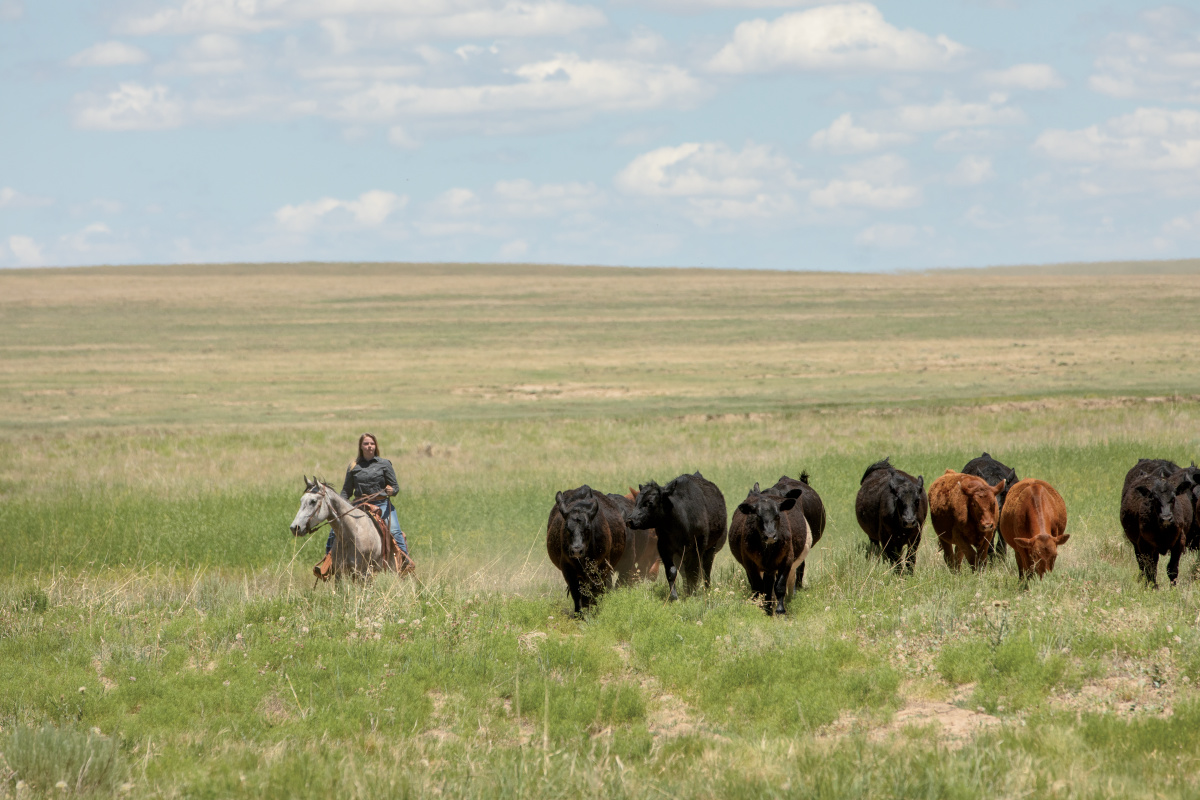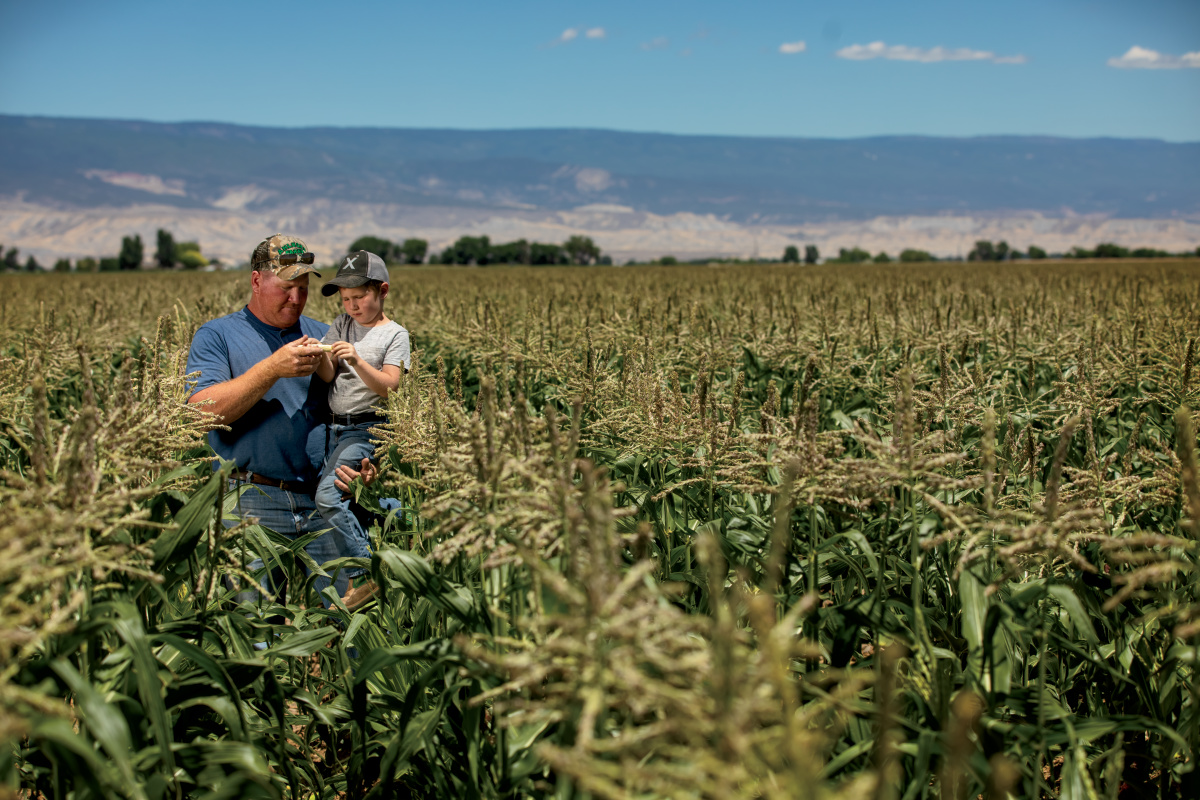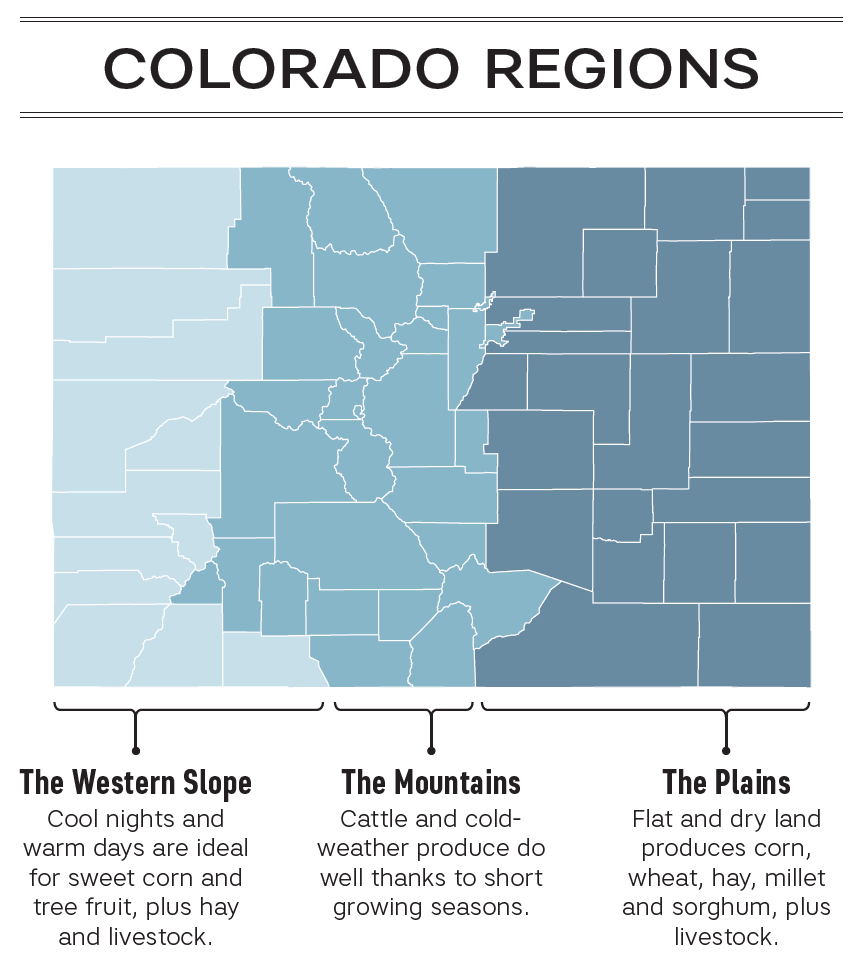Home > Colorado > Colorado Farm to Table > The 3 Distinct Agricultural Regions of Colorado
The 3 Distinct Agricultural Regions of Colorado
In partnership with: Colorado Department of Agriculture

Colorado may be known for the mountains, but its booming agriculture industry reaches from the highest elevations down to the lowest valleys. Boasting 66.33 million total acres and 31.7 million agricultural acres, the state is made up of three distinct agricultural regions – the plains, the Western Slope and the mountains – and each one is home to farmers and ranchers who are proud to call Colorado home.

The Colorado Plains Region
Bordered by the foothills of the Rocky Mountains on the west and Kansas on the east, the Plains are the agricultural heartland of Colorado. The hot days in the Plains and snow-melt irrigation are considered two key ingredients to production of some of the nation’s best melons, grown in Rocky Ford.
READ MORE: Rocky Ford Melons and Other Colorado Products With a National Following
With a semi-arid climate and little rainfall (as little as 14 inches), the eastern plains are largely comprised of small farming communities that also produce crops like corn, wheat, hay, millet, grain sorghum, sunflowers and oats. In addition, this region is home to large dairy operations and hog farms.
It’s also home to a number of livestock ranchers like Christy James. She and her husband run hundreds of beef cattle on more than 3,800 acres in the plains.
“Producers on the eastern plains adjust to a variety of challenges from season to season,” says R.F. Meyer, an agronomist at Colorado State University Extension. From hail and drought to tornadoes that can tear down irrigation systems in minutes, the plains demand resilience.
James says the flat and dry land means fires are a regular concern that can impact the bottom line of a ranch. But despite the challenges that come with working on the plains, James can’t imagine living anywhere else. “The people here are incredible,” she says. “They’ll give you the shirt off their back if you need it. I’ve lived all over and never experienced anything like it.”

The Western Slope of Colorado
Zack Ahlberg began farming in the valleys on the Western Slope of Colorado with his dad when he was in elementary school, but his great-grandfather established their family farm in Delta in 1946.
The Western Slope of Colorado may not be heavily populated, but it makes up nearly 40 percent of the state’s land area. The region experiences cool nights and warm days, which allows farmers to grow delicious crops like sweet corn and tree fruit with irrigation. The state’s famed Palisade peaches are grown here along with apples, berries and a wide variety of produce. It is also the heart of the state’s wine production.
“The temperature swings increase the sugar level in our crops and allow us to raise sweet corn with great flavor,” says Ahlberg. His farm is also home to alfalfa, field corn, onions and beans.
While the weather is comparatively mild and the river water is phenomenal, Ahlberg says irrigating crops in this region can be a challenge.
“We have to work hard to till our ground so we can irrigate properly,” says Ahlberg. “In other areas, farmers can hit the soil once and start planting. We have to go over our fields several times.”

Ranching in the Rocky Mountains
The Rocky Mountains command an impressive presence in Colorado, and also provide an impressive backdrop for ranchers to graze their cattle and sheep on what some would call the nation’s highest-quality forage.
 When he isn’t working as the Western Region Director at CSU Extension, C.J. Mucklow runs cattle on mountain land in Steamboat Springs. He says one of the biggest advantages of ranching in the mountains is the ability to put weight on livestock – and quickly.
When he isn’t working as the Western Region Director at CSU Extension, C.J. Mucklow runs cattle on mountain land in Steamboat Springs. He says one of the biggest advantages of ranching in the mountains is the ability to put weight on livestock – and quickly.
“We have naturally occurring cool-season grasses that our cattle can eat with low inputs and high gains,” says Mucklow. “That matters because we make our money based on how quickly we can put gains on our livestock.”
With short growing seasons and chilly temperatures, farmers can grow cold-weather produce like lettuce and spinach, but the primary crop at these elevations is grass hay. This perennial crop doesn’t require replanting, which makes the area ideal for grazing cattle.
Colorado Proud
From cold mountain winters to the windswept eastern plains, Colorado produces sought-after fruits, vegetables and grains, and exceptional meat and dairy products in its three very diverse agricultural regions. But the greatest production just might be the generations of resilient and determined farmers and ranchers.




[…] The 3 Distinct Agricultural Regions of Colorado – Farm Flavor […]
[…] farmflavor.com […]
Sold out to drugs and violence. The democrats are destroying the state that once was a destination for many good people who now find it a dangerous and losing opportunity.
My option to retire there and bring the family in has changed as well as many thousands of others.
Willard – Reading your comment that states you no longer plan to retire in Colorado makes me sad. I wanted to reply, because I actually have some insight into the concerns you mentioned. (For 22 years, I’ve worked as a public safety analyst, which basically means I break down crime statistics, root causes, and advise public and private agencies regarding policy. Full disclosure, I’m conservative & solid red voter. I’m not a fan of the Dem party, but they have nothing to do with uptick in crime). We had a spike in crime here in CO that began back at the start of the pandemic. Every state had a near-identical rise during the same period, across party lines. This is because people, en mass, were out of work, facing financial hardship, there was panic, and suddenly just about everyone had a heck of a lot more time on their hands. Sadly some chose to spend that free time getting up to no good. Here’s the positive: As jobs came back, crime went down, and continues to. This is exactly what we would expect to see and it should continue to lower. The 1 issue that IS getting worse here is car theft, we have the highest levels in the country. BUT we also have the most numbers of the “hot” cars that get the most $ (SUVS & Trucks) compared to every other state. If you’re looking for diamonds, you’d go to a jewelry store, not a grocery store. I really suggest, kindly, rethink where you’re getting your media from. Working in this field, every day I hear “crime rates went up because of republicans” from the dems/CNN watchers, and “crime rates went up because of democrats” from my party/Fox watchers. Reality is, crime rate changes have little to do with what party holds the power or else we’d see major shifts as the power changes hands. Sick of hyper partisan media misinforming the public.
Thanks for that reasonable insight! Gives me hope that we can hold thoughtful, respectful discussion and hopefully keep our government functional. (With plenty of faults, the government does function, and I always recommend international travel for those who take that functioning for granted). I am just checking out this website as a person looking to start a regenerative farm in CO.
Ryan you hit it right on the nose!!!!!!!!
Thank you for this! Very informative and educational for all!